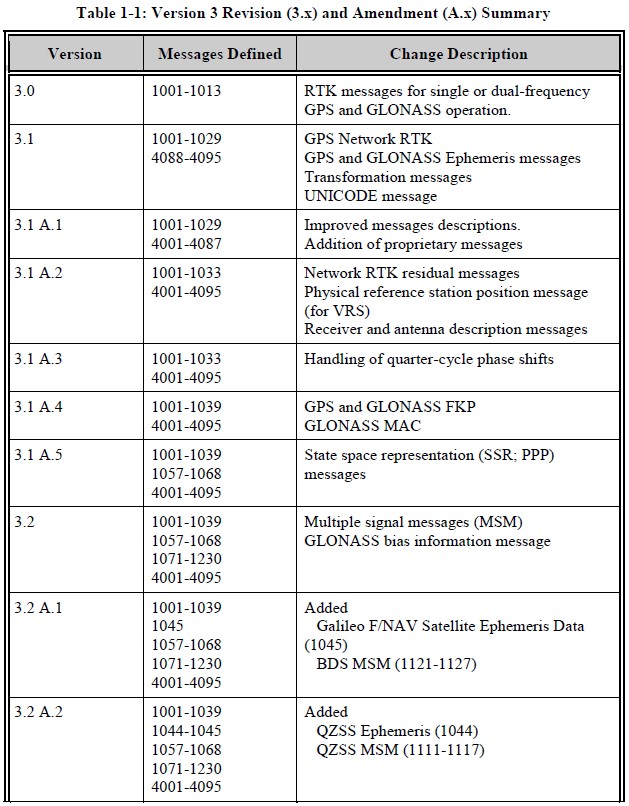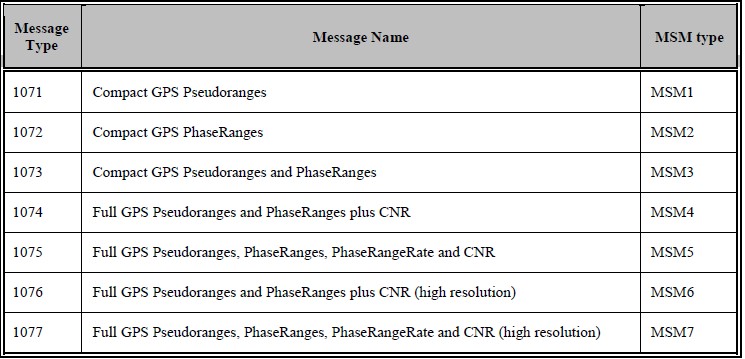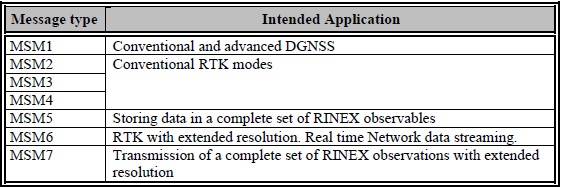New additions in RTCM-3 and What is MSM
Following the general introduction of RTCM in the previous article, this article will focus on describing the new additions of the current new version of RTCM-3.X and particularly the important Multiple Signal Messages (MSM).
RTCM-3 Change Description
With the addition of new technologies and new GNSS (including new systems in operation and planned), the old standard protocols could no longer support the most stringent application requirements in an efficient manner, so new message types were added to accommodate the new information and technology.
RTCM version 3, the current and evolving version of the RTCM standard, combine messages together with associated data instead of sending separate messages to accomplish the same task.
According to the official release of RTCM STANDARD, several versions of RTCM-3.X have successively added the following important message types:
Version 3.1: GPS Network RTK, GPS Ephemeris Information (1019), GLONASS Ephemeris Information (1020), State Space Representation (SSR, PPP) Information (1057-1068)
Version 3.2: Multiple Signal Messages (MSM, GPS MSM 1071-1077, GLONASS MSM 1081-1087, Galileo 1091-1097), GLONASS Bias Information (1230), Galileo F/NAV Ephemeris Information (1045), QZSS Ephemeris Information (1044), B DS MSM (1121-1127), QZSS MSM (1111-1117)
Version 3.3: BDS ephemeris information (1042), Galileo I/NAV ephemeris information (1046), S BAS MSM (1101-1107)
RTCM-3 adds ephemeris information, provides orbit updates, and can be used for faster locking signals. The GPS and GLONASS ephemeris were first expanded in RTCM-3.1, followed by RTCM-3.2 and 3.3 added Galileo, QZSS and BDS ephemeris.
And in version 3.2, a new message type, Multiple Signal Messages (MSM), was proposed, which will be introduced separately below.
In addition, the very important GLONASS bias information is added, which is key information for GNSS manufacturers that offer GLONASS receivers in modelling and ambiguity fixing. The root cause is that GLONASS uses frequency division multiplexing (FDMA) to distinguish each satellite signal, which is different from code division multiplexing (CDMA) used by GPS. This results in a certain inter-frequency deviation.


RTCM version and message change discription
Multiple Signal Messages (MSM)
At the same time as the addition of new GNSS systems and signals, a large number of GNSS signals and observation data are presented in proprietary formats, and the previous approach of achieving compatibility through RINEX-3 conversion has no effective real-time interoperability.
The standardized GPS and GLONASS RTCM-3 messages, which cannot be effectively extended to other GNSS systems and other signals, are limited to L1 and L2 frequency bands and to only one signal per band. MSM (Multiple Signal Messages) added in RTCM-3.2 realizes the maximum compatibility with RINEX-3 and is used to replace legacy RTCM-3 messages (such as MT1001-1004, MT1009-1012).
MSM transmits essential information in a more general form, making encoding and decoding more convenient and flexible, and providing better scalability.
Taking GPS (RTCM 1004, GPS L1 and L2 code, phase and ambiguity, and carrier-to-noise ratio) as an example, only one of L1C/A, L1C, and L2C can be broadcast, while MSM can contain all frequency band signals.
The BDS information was only supported after RTCM-3.2 launched MSM. In today's multi-constellation and multi-frequency application mode, MSM has become the first choice, unless there is a bandwidth limitation or old machines will use the message information such as 1001-1004 and 1009-1012 that should be eliminated.
In addition, in differential positioning, the base station can broadcast the information of all frequency bands of the satellite system, and the mobile station often supports one of the frequency bands that is preferentially selected by the manufacturer. For example, if we choose between L2p and L2c, L2c will be given priority.
There are different types of Multiple Signal Messages (MSM). Taking GPS MSM as an example, the information included is as follows:

GPS MSM information
Notes: The first three digits of the message type number 107 represent GPS, 108 represent GLONASS, 109 represent Galileo, 111 represent QZSS, and 112 represent BDS. The last digit represents the content type of the data type MSM: 1~7.
The MSMs are split into compact messages and full messages, similar to the current RTCM approach (e.g., 1003 and 1004, or 1011 and 1012).
Message MSM1-MSM5 are standard precision messages, and MSM2 contains only Phaserange observables, providing greater flexibility when dealing with low-bandwidth data links and/or high-rate transmissions.
For example, the reference station can transmit MSM2 at a rate as high as possible, while occasionally inserting MSM3 or MSM4 messages to provide additional pseudorange and carrier-to-noise ratio (CNR) data, which typically are not required at a high rate.
Whereas MSM6 and MSM7 are high precision messages, containing the same fields as MSM4 and MSM5 representatively, but with a higher resolution.
For these six MSMs, the proposed messages have the following intended applications:

Six MSMs and intended application
(Reference: RTCM STANDARD 10403.3)
About Tersus GNSS Inc.
Tersus GNSS is a leading Global Navigation Satellite System (GNSS) solution provider. Our offerings and services aim to make centimeter-precision positioning affordable for large-scale deployment.
Founded in 2014, we have been pioneers in design and development GNSS RTK products to better cater to the industry’s needs. Our portfolios cover GNSS RTK & PPK OEM boards, David GNSS Receiver, Oscar GNSS Receiver, MatrixRTK [GNSS CORS Systems] and inertial navigation systems.
Designed for ease of use, our solutions support multi-GNSS and provide flexible interfaces for a variety of applications, such as UAVs, surveying, mapping, precision agriculture, lane-level navigation, construction engineering, and deformation monitoring.
Sales inquiry: sales@tersus-gnss.com
Technical support: support@tersus-gnss.com
